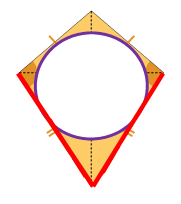Skip over navigation
Preveina from Crest Girls' Academy sent us some pictures to support her reasoning about some of the shapes in this problem:
A circle can be always fitted in a square touching all 4 sides since the sides of a square are all equal. This makes the circle touch each side of the square evenly.
A circle can never be fitted in to a rectangle touching all 4 sides because a rectangle has 2 long sides and 2 short sides. When you're trying to draw a circle that touches all 4 sides in a rectangle it'll turn out to be an oval, since there are 2 long sides.







Or search by topic
Number and algebra
Geometry and measure
Probability and statistics
Working mathematically
Advanced mathematics
For younger learners
Circles in Quadrilaterals
Age 14 to 16
Challenge Level 





- Problem
- Getting Started
- Student Solutions
- Teachers' Resources
Preveina from Crest Girls' Academy sent us some pictures to support her reasoning about some of the shapes in this problem:
A circle can be always fitted in a square touching all 4 sides since the sides of a square are all equal. This makes the circle touch each side of the square evenly.
A circle can never be fitted in to a rectangle touching all 4 sides because a rectangle has 2 long sides and 2 short sides. When you're trying to draw a circle that touches all 4 sides in a rectangle it'll turn out to be an oval, since there are 2 long sides.

A circle can never be fitted in to a
parallelogram touching all 4 sides because a parallelogram has 2
long sides and 2 short sides just like a rectangle has.

A circle can also be fitted in to a
kite touching all 4 sides.

The circle can be sometimes fitted
into the trapezium touching all 4 sides depending on the length of
the sides. If the non-parallel sides are too far apart, the circle
becomes stretched into an oval.

You may also like
Bendy Quad
Four rods are hinged at their ends to form a convex quadrilateral. Investigate the different shapes that the quadrilateral can take. Be patient this problem may be slow to load.
Lawnmower
A kite shaped lawn consists of an equilateral triangle ABC of side 130 feet and an isosceles triangle BCD in which BD and CD are of length 169 feet. A gardener has a motor mower which cuts strips of grass exactly one foot wide and wishes to cut the entire lawn in parallel strips. What is the minimum number of strips the gardener must mow?
Long Short
What can you say about the lengths of the sides of a quadrilateral whose vertices are on a unit circle?

